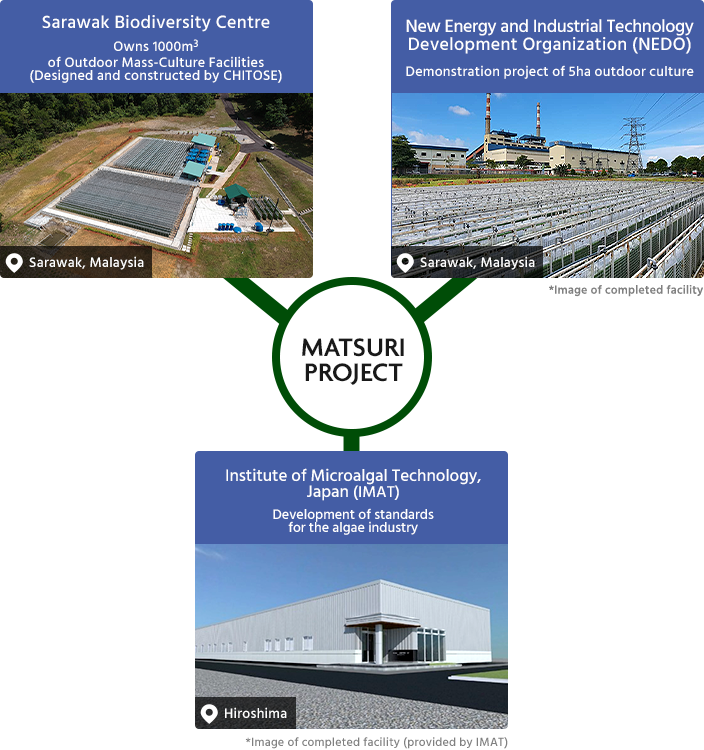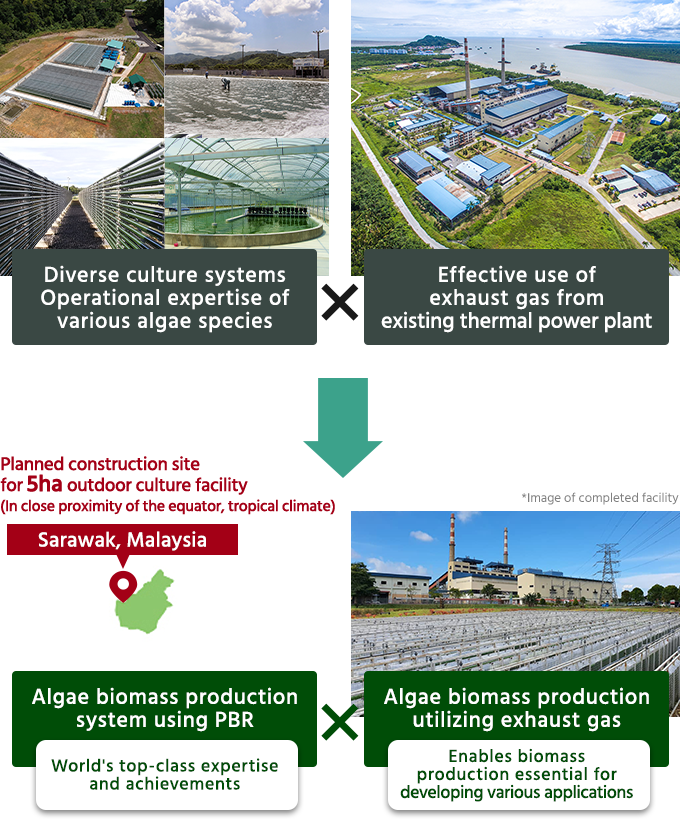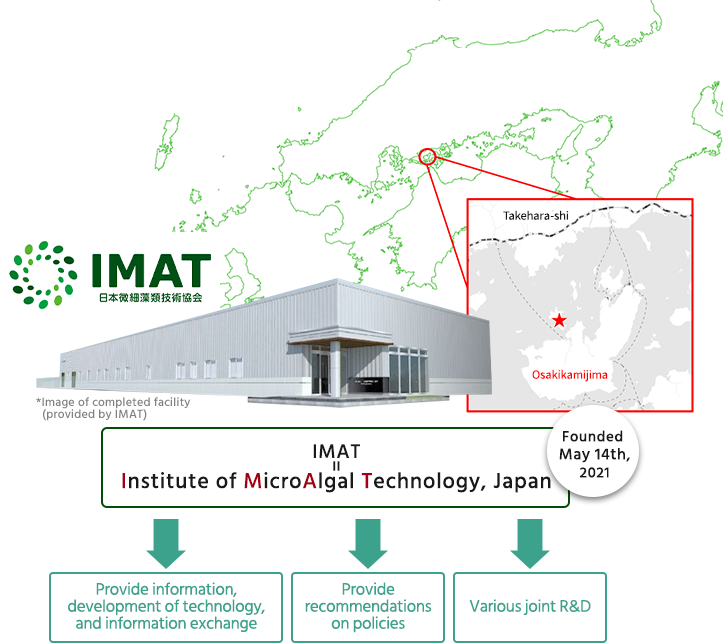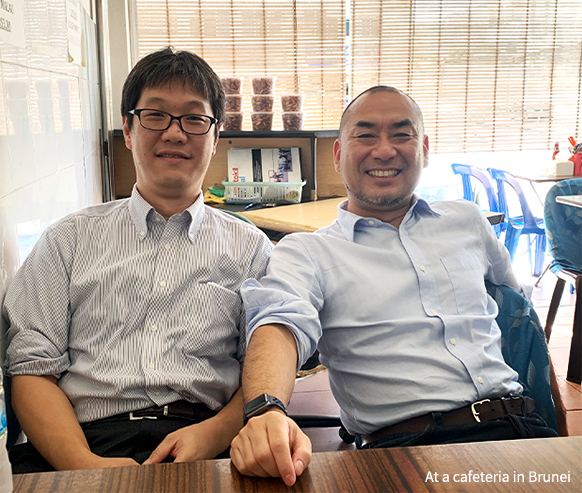What's MATSURI
MATSURI is the world’s first joint project where various players from multiple industries come together and share knowledge to develop an "advanced society based on algae”.
What's MATSURI
The objective of MATSURI is not only to discuss aspirations and ideals from the viewpoint of Research and Development (R&D), but also to engage in open, fact-based scientific discussions, fully utilizing the knowledge and achievements of CHITOSE GROUP gained through the years in the development of a new algae industry. By engaging diverse players into MATSURI, we aspire to broaden its influence through the realization of passionate yet realistic and practical projects.
We welcome leading companies of various industries interested in developing algae-related businesses to join us as Industry Structuring Partners and participate in discussions to build the algae industry structure (=MATSURI Working Group). These crucial discussions are at the core of MATSURI. Through these discussions, the basic structure of the future industry - including investments structure and expected return on investment (ROI) – will be decided.
Corporate Partners will be able to identify their roles and positions in the industry as they gain access to information on discussions in the MATSURI Working Group through MATSURI secretariat. Various knowledge on algae will also be provided; enabling Corporate Partners to gradually enhance their involvement in the upcoming industry.
In addition to discussions on the design of the future algae industry, MATSURI will also develop algae-derived products on a commercial scale. Outreach to the wider community about our movement will be done through dissemination of information to the public on any developments and algae-derived products launch.
As more players become involved in our movement, we will become the global pioneers in the actualization of the algae industry. This strong will and belief are the driving force of MATSURI.
Execution Structure
As we conduct the world’s most advanced R&D in the field, we will have intense discussions in the MATSURI Working Group towards the development of an execution plan for commercialization/Industrialization. We will constantly inform the public and raise awareness regarding these execution plans.
MATSURI
SECRETARIAT
- SHARING/COMMUNICATING INFORMATION
- ●Communication to society / government
Communication through events and utilization of web media - ●Workshops and Study Sessions
Information sharing between participants
Provide Information
- Management of the MATSURI Working Group
- ●A1:Industrial Structure Group
Discuss and identify the role of each company within the industrial structure - ●A2: Life Cycle Assessment (LCA) / Techno-Economic Assessment (TEA) Group
Discuss quantitatively environmental and economic efficiency - ●B1: Application Development Group
Discuss and identify the principles and development methods of final products - ●B2: Production Equipment Group
Discuss cutting edge algae production equipments / technologies
Provide Information
- RESEARCH & DEVELOPMENT
- ●Intellectual property / information management
Management of intellectual property resulting from each research - ●Research management
Plan, manage, and implement experiments, research and surveys -
- Production Research A
- Production Research B
- Processing Research A
- Processing Research B
- Processing Research C
- Application Research A
- Application Research B
- Application Research C
- Academic Survey A
- Industry Survey A
LCA: Life Cycle Assessment /
TEA: Techno-Economic Assessment /
RA: Resources Assessment
MATSURI's LINKAGE WITH
SUPPORTERS/COLLABORATORS
To develop evaluation criteria and industry standards, we will collaborate with the IMAT (Institute of Microalgal Technology, Japan). For the demonstration of large-scale outdoor mass cultivation, we will partner with the Sarawak Biodiversity Center and NEDO (New Energy and Industrial Technology Development Organization) under the Ministry of Economy, Trade and Industry to realize our objectives.

Outdoor Large-Scale Culture Demonstration Project by NEDO
Chitose Research Institute carried out a project of building the world’s largest outdoor 5 ha culture demonstration project, entrusted by NEDO to develop technologies for the production of bio-jet fuel from algae. Located in close proximity to the equator in the tropics with abundance of sunlight, we will be making effective use of PhotoBioReactor (PBR) technology and exhaust gas from an existing power plant for algae production. Through this project we will collaborate with the MATSURI project in the joint research, to make improvement of the economic efficiency along with advancement of future bio-jet fuel production.

Institute of Microalgal Technology, Japan (IMAT)
The objective is to develop procedures and necessary requirements for a more systematic and efficient R&D production of microalgae.
A test bed will be constructed enabling the acquisition of standardized data to be obtained through various tests using standard methods on biomass productivity, economics, and environmental factors.
Relevant information will be shared for the discussion on the assumptions and boundary conditions essential for standardization. Recommendations to the industry and government entities will be made in collaboration with various algae-related projects including MATSURI.
 Selection of algae species and establishment of culture system
Selection of algae species and establishment of culture system
-
 3 Types of Basic culture system / Standardization of culture and measurement conditions
3 Types of Basic culture system / Standardization of culture and measurement conditions
-
 Standardization of Climate Conditions
Standardization of Climate Conditions
-
 Implementation of various downstream processes / Standardization of Methods
Implementation of various downstream processes / Standardization of Methods





